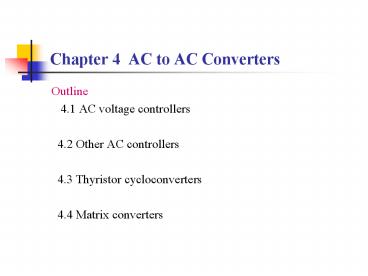Chapter 4 AC to AC Converters - PowerPoint PPT Presentation
1 / 25
Title:
Chapter 4 AC to AC Converters
Description:
4.1.1 Single-phase AC voltage controller. Resistive load, ... 4.2.3 Chopping control AC chopper. AC chopper. Modes of operation. 4.3 Thyristor cycloconverters ... – PowerPoint PPT presentation
Number of Views:4964
Avg rating:3.0/5.0
Title: Chapter 4 AC to AC Converters
1
Chapter 4 AC to AC Converters
- Outline
- 4.1 AC voltage controllers
- 4.2 Other AC controllers
- 4.3 Thyristor cycloconverters
- 4.4 Matrix converters
2
4.1.1 Single-phase AC voltage controller
3
- Resistive load, quantitative analysis
- RMS value of output voltage
- RMS value of output current
- RMS value of thyristor current
- Power factor of the circuit
4
- Inductive (Inductor- resistor) load , operation
principle
5
- Inductive load, quantitative analysis
- Differential equation
- The RMS value of output voltage, output current,
and thyristor current can then be calculated.
6
4.1.2 Three-phase AC voltage controller
- Classification of three- phase circuits
7
- 3- phase 3- wire Y connection AC voltage
controller - For a time instant, there are 2 possible
conduction states - Each phase has a thyristor conducting. Load
voltages are the same as the source voltages. - There are only 2 thyristors conducting, each
from a phase. The load voltages of the two
conducting phases are half of the corresponding
line to line voltage, while the load voltage of
the other phase is 0.
8
4.2 Other AC controllers
- 4.2.1 Integral cycle controlAC power controller
- Circuit topologies are the same as AC voltage
controllers. - Only the control method is different.
- Load voltage and current are both sinusoidal when
thyristors are conducting.
9
- Spectrum of the current inAC power controller
- There is NO
- harmonics in the
- ordinary sense.
- There is harmonics
- as to the control
- frequency. As to the
- line frequency, these
- components become
- fractional harmonics.
10
4.2.2 Electronic AC switch
- Circuit topologies are the same as AC voltage
controllers. But the back- to- back thyristors
are just used like a switch to turn the equipment
on or off. - ApplicationThyristor-switched capacitor (TSC)
11
- TSC waveforms when the capacitor is switched
in/out - The voltage across the thyristor must be nearly
zero when switching in the capacitor, and the
current of the thyristor must be zero when
switching out the capacitor.
12
- TSC with the electronic switch realized by a
thyristor and an anti-parallel diode - The capacitor voltage will be always charged up
to the peak of source voltage. - The response to switching- out command could be a
little slower (maximum delay is one line-cycle).
13
4.2.3 Chopping controlAC chopper
- AC chopper
- Modes of operation
14
4.3 Thyristor cycloconverters
- 4.3.1 Single- phase thyristor-cycloconverter
- Circuit configuration and operation principle
15
- Single- phase thyristor-cycloconverter
- Modes of operation
16
- Typical waveforms
17
- Modulation methods for firing delay angle
- Calculation method
- For the rectifier circuit
18
(No Transcript)
19
4.3.2 Three- phase thyristor-cyclo converter
- The configuration with common input line
20
- The configuration with star-connected output
21
- Typical waveforms
22
- Input and output characteristics
- The maximum output frequency and the harmonics in
the output voltage are the same as in
single-phase circuit. Input power factor is a
little higher than single-phase circuit.
Harmonics in the input current is a little lower
thanthe single- phase circuit due to the
cancellation of some harmonics among the 3
phases. - To improve the input power factor
- Use DC bias or 3k order component bias on
each of the 3 output phase voltages - Features and applications
- Features
- Direct frequency conversionhigh efficiency
- Bidirectional energy flow, easy to realize
4- quadrant operation - Very complicatedtoo many power
semiconductor devices - Low output frequency
- Low input power factor and bad input current
waveform - Applications
- High power low speed AC motor drive
23
4.4 Matrix converter
- Circuit configuration
24
- Usable input voltage
25
- Features
- Direct frequency conversionhigh efficiency can
realize good input and output waveforms, low
harmonics, and nearly unity displacement factor - Bidirectional energy flow, easy to realize 4-
quadrant operation - Output frequency is not limited by input
frequency - No need for bulk capacitor (as compared to
indirect frequency converter) - Very complicatedtoo many power semiconductor
devices - Output voltage magnitude is a little lower as
compared to indirect frequency converter.































